Located off northwestern Australia, the Great Barrier Reef ranks as the world’s largest coral reef system. It stretches for over 1,400 miles and includes 2,900 separate reefs and 900 islands. This makes the Great Barrier Reef not only the largest reef but also the largest structure made by living organisms in the world. In total, more than 1,500 fish species call the reef home, as well as whales, dolphins, and dugongs. Let’s take a close look at ten incredible fish that live around the Great Barrier Reef.
1. Clownfish
Most people recognize clownfish as the titular characters from Pixar’s Finding Nemo franchise. You can find more than 30 different clownfish species in the warm waters of the Indo-Pacific and around the Great Barrier Reef. These include the clown anemonefish (Amphiprion percula) and the false clown anemonefish (A. ocellaris), which feature distinctive orange and white banding.
Clownfish form a symbiotic relationship with host anemones. Anemones provide clownfish with protection and food scraps left over from their meals. Meanwhile, clownfish protect anemones from predators and parasites and also provide anemones with nutrients via their fecal matter.
Clownfish are sequential hermaphrodites, meaning that all clownfish begin life as males. They live in groups that include just one dominant male and female. If a female leaves the group, one dominant male will develop into a female and take her place.

Clownfish form a symbiotic relationship with host anemones.
©Alex Stemmers/Shutterstock.com
2. Parrotfish
Parrotfish are a common sight around the Great Barrier Reef and coral reefs throughout the Indo-Pacific. Approximately 90 parrotfish species exist within the family Scaridae, including the princess, queen, and green humphead parrotfish.
Parrotfish get their name from their unique appearance. They possess a parrot-like beak formed of tightly-packed teeth on the outside of the jaw bones. Parrotfish use their teeth to scrape algae off of coral reefs and other rocky surfaces. This behavior makes parrotfish a primary cause of bioerosion, as their teeth can damage coral reefs and other structures.
Some parrotfish sleep in a protective cocoon made from mucus that they extrude from their mouths. Like clownfish, most parrotfish are sequential hermaphrodites. However, rather than starting male and becoming female, parrotfish typically start as females and then change into males.
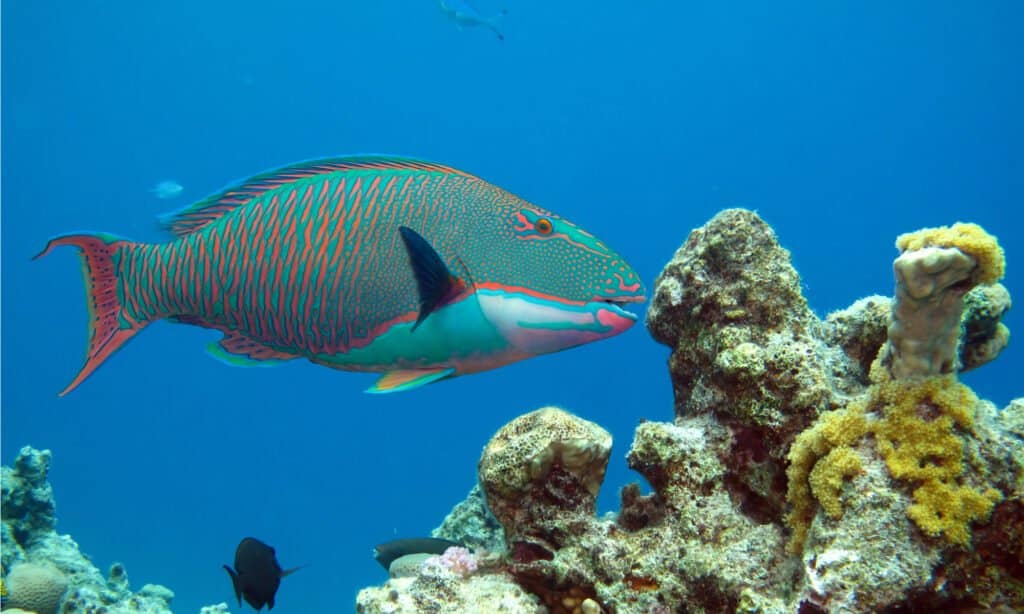
The parrotfish uses its beak-like teeth to grasp algae from corals and rocks.
©Cigdem Cooper/Shutterstock.com
3. Surgeonfish
Acanthuridae comprises around 86 known species collectively known as surgeonfish, tang, or unicornfish. These brightly colored fish live in tropical waters and frequently make their homes in coral reefs. You’ll likely recognize one species, the royal blue tang, as Dory of Finding Nemo fame.
Surgeonfish get their name from the sharp, scalpel-like scales on either side of the tail. These razor-sharp scales can cause deep lacerations if you handle a surgeonfish carelessly. Surgeonfish vary in appearance, with most measuring between 6 and 15.5 inches and featuring bright colors and striking patterns.
In the wild, surgeonfish mostly feed on algae, helping to maintain coral reefs’ health. Some species also eat algae off of the bodies of other fish. While they often feed and travel in schools, surgeonfish will occasionally feed on their own.
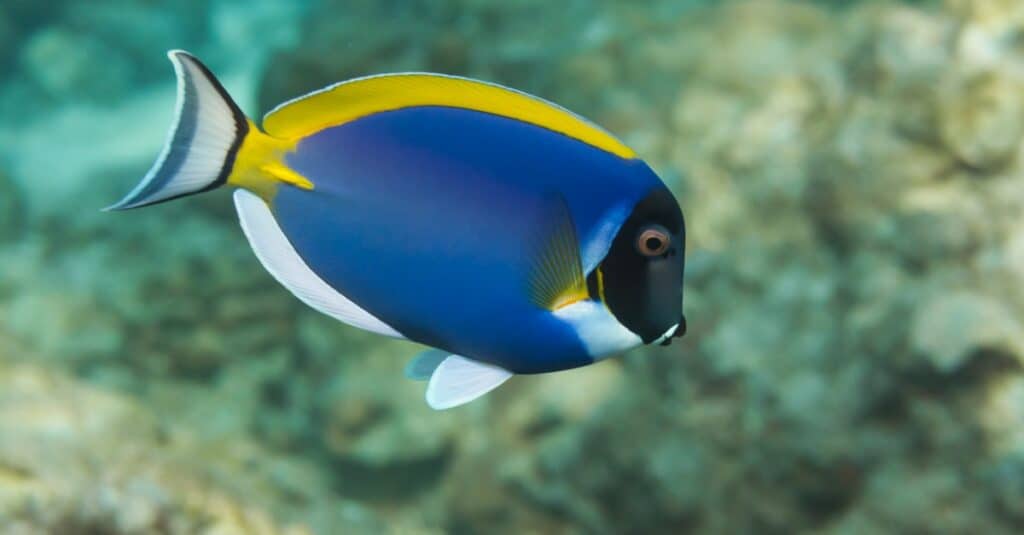
Surgeonfish get their name from the sharp, scalpel-like scales on either side of the tail.
©iStock.com/tae208
4. Manta Rays
Manta rays are giant rays belonging to the genus Mobula. The genus includes two species, the larger giant manta ray (M. birostris) and the smaller reef manta ray (M. alfredi). As their name implies, reef manta rays typically live in shallow coastal waters and around coral reefs such as the Great Barrier Reef.
Reef manta rays typically measure between 9.8 and 11.5 feet wide but can grow up to 18 feet. They feature a dark dorsal side and a characteristic “Y-shaped” light marking on top of the head.
Manta rays are filter feeders that feed on zooplankton and other microorganisms. They possess the largest brain weight-to-body ratio of any fish and display high levels of intelligence. Despite their large size, manta rays pose no threat to humans. Unfortunately, manta ray populations have significantly declined over the last few decades due to overfishing. Today, the IUCN classifies manta rays as Vulnerable species.
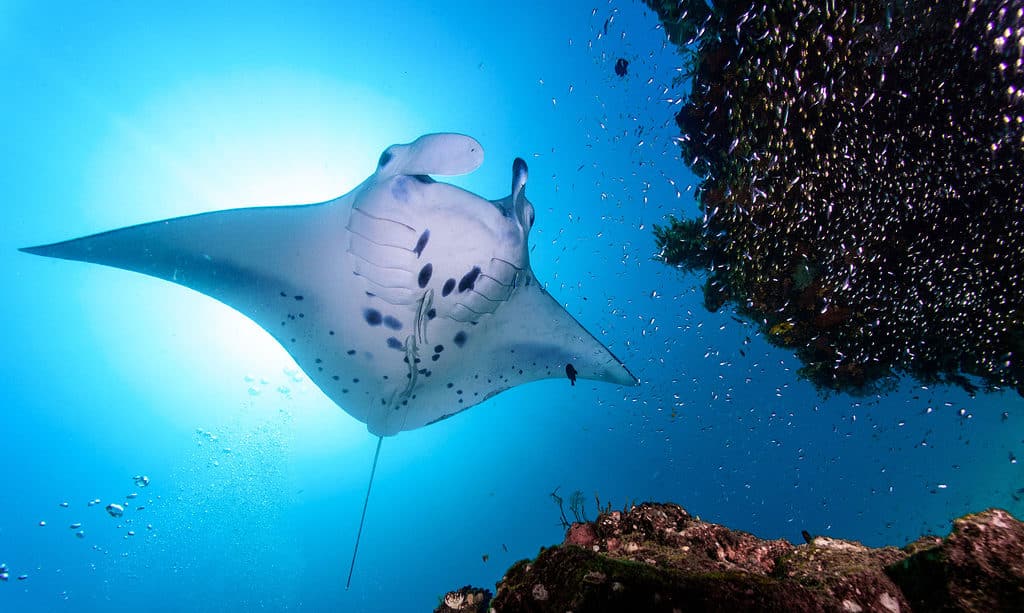
Manta rays possess the largest brain weight-to-body ratio of any fish and display high levels of intelligence.
©Hoiseung Jung/Shutterstock.com
5. Butterfly Fish
Butterfly fish are colorful tropical fish in the Chaetodontidae family. The family consists of 129 unique species spread out over 12 genera. Most butterfly fish live on coral reefs in the Indo-Pacific and Atlantic Oceans.
Butterfly fish are easily recognizable thanks to their flat, brightly colored bodies. They can change their color depending on the situation, varying from bright to dull to match their surroundings. Their flat bodies appear somewhat like the wings of a butterfly, hence their name. They possess long snouts filled with bristle-like teeth that they use to grab prey from small cracks and crevices in coral reefs. Most species measure 4.7 to 8.7 inches long, but some can measure up to 12 inches long.
Butterfly fish bond in monogamous pairs for several years and often mate for life. They frequently travel in schools but can act highly territorial toward other butterfly fish.
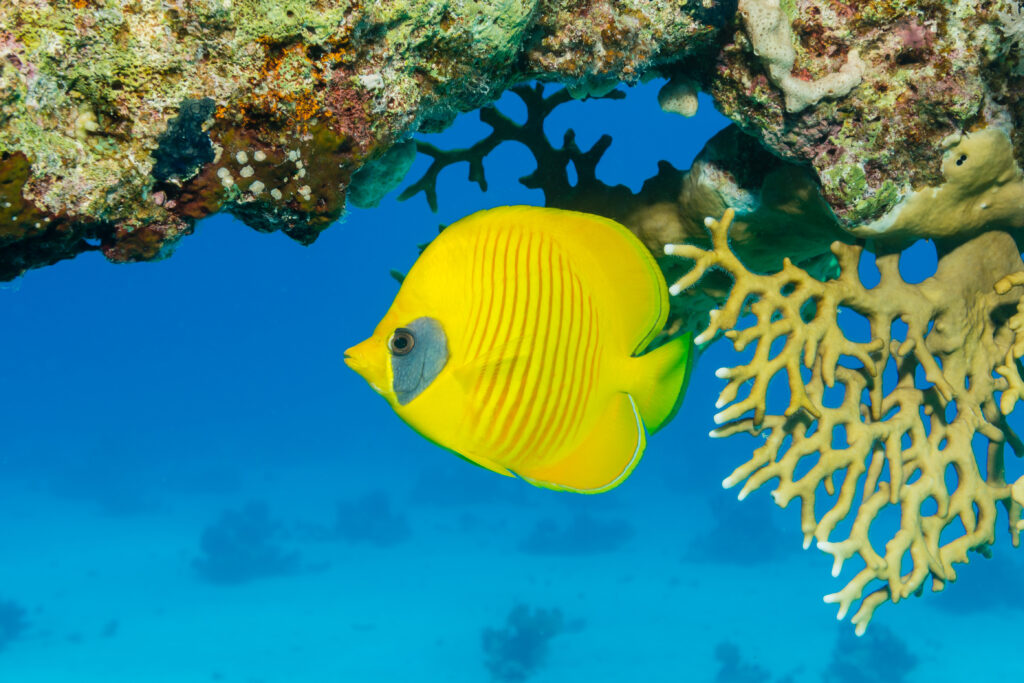
Butterfly fish
are easily recognizable thanks to their flat, brightly colored bodies.
©kaschibo/Shutterstock.com
6. Angelfish
Marine angelfish belong to the family Pomacanthidae. You can find these colorful tropical fish through the Atlantic and Indian Oceans. That said, most of the 90 known angelfish species live in the western Pacific Ocean. They live in shallow coastal waters and around coral reefs.
In terms of appearance, angelfishes somewhat resemble butterfly fish thanks to their colorful, compressed bodies. Angelfish range in size from just 5.9 inches long to nearly 24 inches long. However, most species range between 7.9 and 11.8 inches long.
Angelfish are known to be quite bold and tend to show little fear of divers. While some species live in monogamous pairs, others live in groups that consist of an alpha male and a group of breeding females. The majority of angelfish feed on sponges, although some are specialist feeders that primarily eat zooplankton or algae.
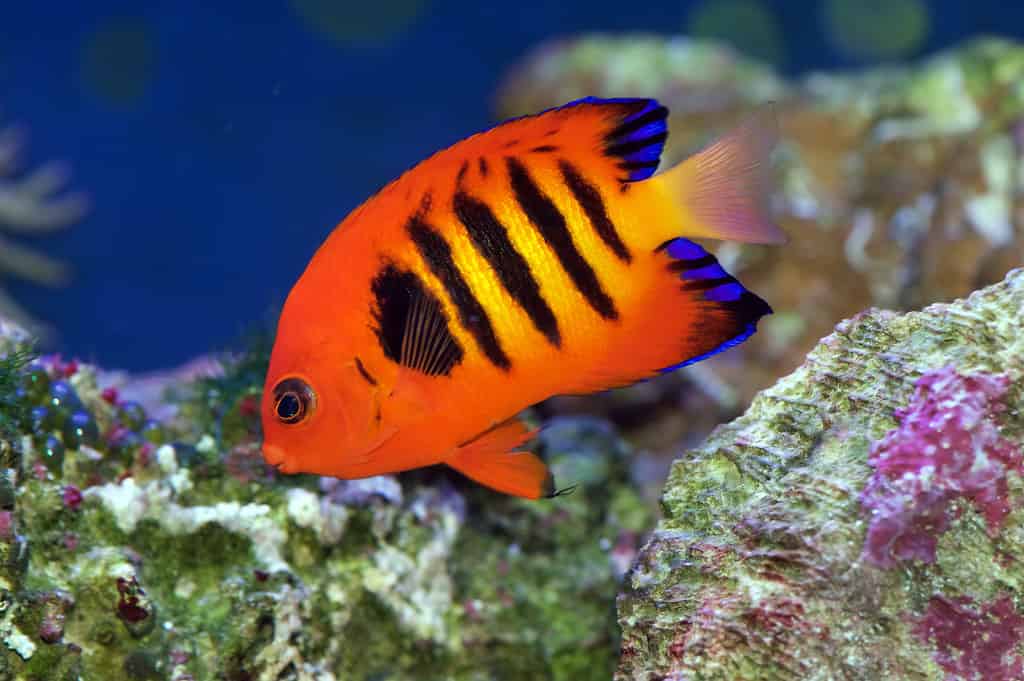
Angelfish are known to be quite bold and tend to show little fear of divers.
©PAUL ATKINSON/Shutterstock.com
7. Triggerfish
The term triggerfish refers to around 40 different species in the family Balistidae. These colorful tropical fish primarily live in the Indo-Pacific, although you can find them around coral reefs worldwide.
Most triggerfish species measure between 8 and 20 inches long, but some species can grow up to 3.3 feet. They possess flat, oval-shaped bodies and large heads with small, powerful jaws well-suited for crushing shells. Triggerfish can raise their front two dorsal spines, the first of which can only be lowered by lowering the second “trigger spine.” This feature is where the name “triggerfish” comes from.
Triggerfish primarily prey on crustaceans, sea urchins, and mollusks. While popular in the aquarium trade, triggerfish are known to be quite aggressive and bad-tempered. Some species will even aggressively defend their territory against much larger animals, including divers.

Triggerfish aggressively defend their territory against much larger animals, including divers.
©Vladimir Wrangel/Shutterstock.com
8. Porcupinefish
Not to be confused with the pufferfish in the family Tetraodontidae, porcupinefish belong to the family Diodontidae. Also known as blowfish, balloonfish, or globefish, porcupinefish inhabit shallow, tropical waters worldwide.
Porcupinefish are medium-sized, slow-moving fish that feed primarily on mollusks and sea urchins. To ward off predators, porcupinefish swallow water or air to increase their size by nearly double. However, their most potent defense mechanism comes in the form of a deadly neurotoxin and tetrodotoxin produced by their organs. This toxic cocktail can kill large predators and also humans.
Despite their toxicity, main countries consider porcupinefish meat a delicacy. Preparing porcupinefish for consumption requires skill and special attention. Still, thrill-seeking diners continue to consume porcupinefish despite the fact that no antidote exists for porcupinefish toxin.

Porcupinefish have spiny, needle-like scales that cover their bodies, making them difficult for predators to swallow.
©Jesus Cobaleda/Shutterstock.com
9. Humphead Wrasse
The humphead wrasse (Cheilinus undulatus) is the largest species in the wrasse family Labridae. It also goes by the name the “Maori wrasse,” “Napoleon wrasse,” or “Napoleon fish.” Humphead wrasses live around coral reefs throughout the Indo-Pacific.
Male humphead wrasses measure larger than females and can reach up to 6.5 feet long, and weigh nearly 400 pounds. That said, most specimens average around 3 feet long. They vary in color from blue-green to purplish-blue. They feature large lips and a characteristically large hump on the forehead, hence their name.
Humphead wrasse mature at 5 to 7 years old and can live for up to 30 years. However, due to their slow rate of reproduction, humphead wrasse populations have declined in recent decades because of habitat loss and overfishing. As a result, the IUCN lists the humphead wrasse as an Endangered species.
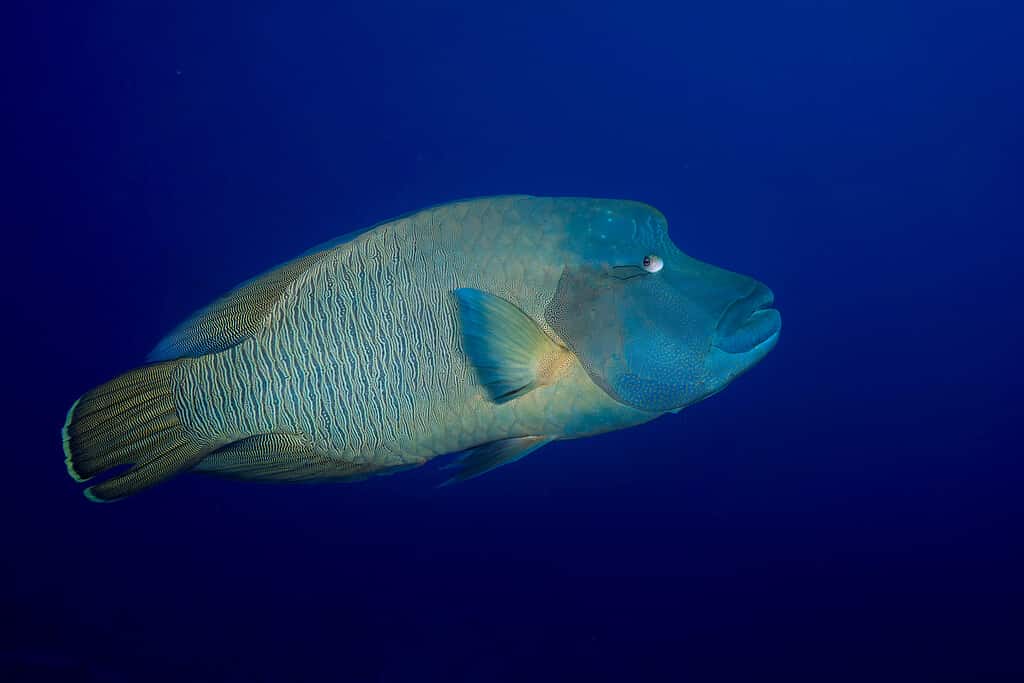
Humphead wrasse feature large lips and a characteristically large hump on the forehead, hence their name.
©imageBROKER.com/Shutterstock.com
10. Coral Grouper
The coral group (Cephalopholis miniata) goes by many other names, including the “coral trout,” “coral cod,” and “vermillion seabass.” Coral groupers occur throughout the Indo-Pacific. They often inhabit caves and ledges in coral reefs, which provide them with food and protection.
Coral groupers possess streamlined bodies that measure around 20 inches at maximum length. In terms of color, they range from reddish brown to orange-red and feature blue spots all over their heads, bodies, and fins.
Like other groupers, coral groupers are carnivorous and prey mostly on smaller fish and crustaceans. They frequently ambush their prey by hiding behind coral or inside caves or crevices. Coral groupers live in groups of a single dominant male and several females. Females will defend their territory against other females and occasionally change their sex to male.

Coral groupers are hermaphrodites — they can change genders when external circumstances require it.
©DiveSpin.Com/Shutterstock.com
The photo featured at the top of this post is © JennyHuang / Creative Commons / Original
Thank you for reading! Have some feedback for us? Contact the AZ Animals editorial team.






